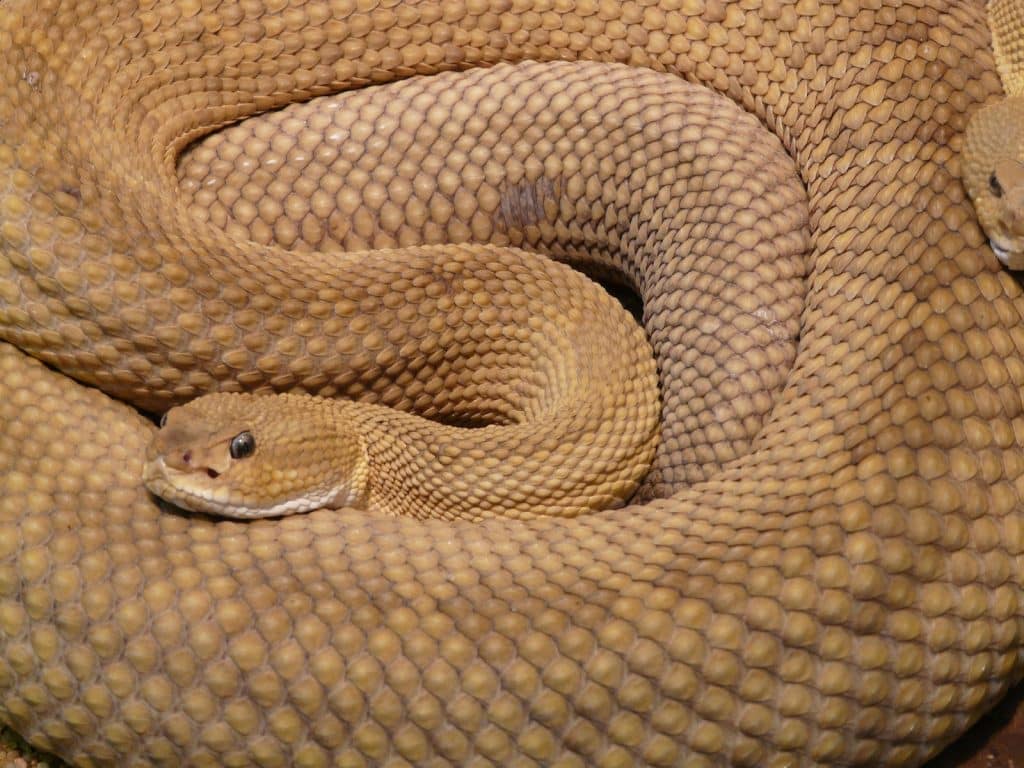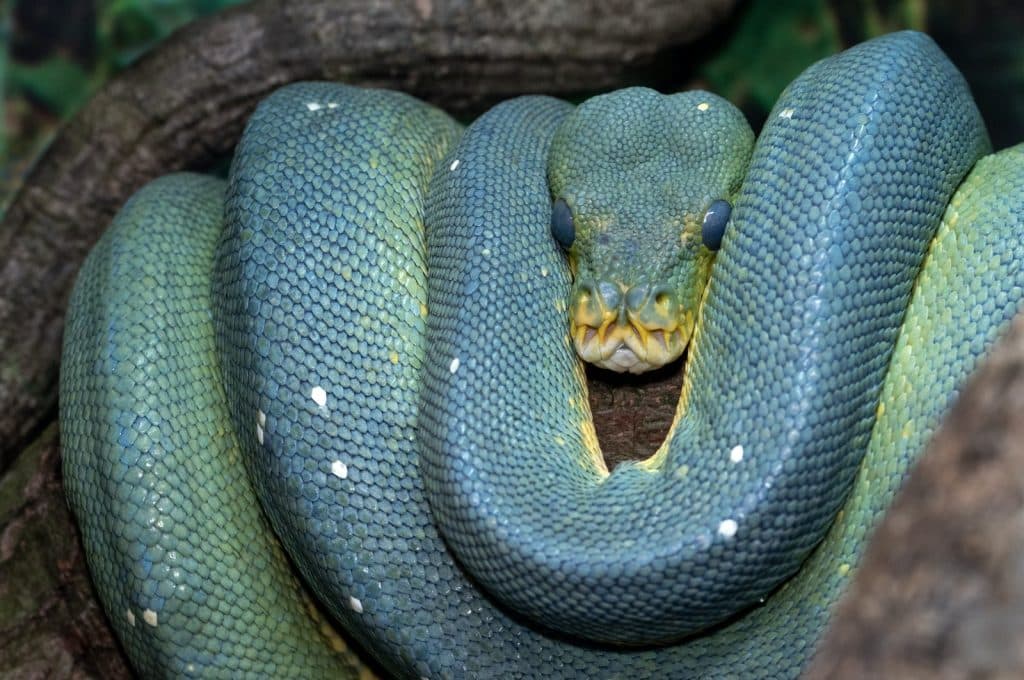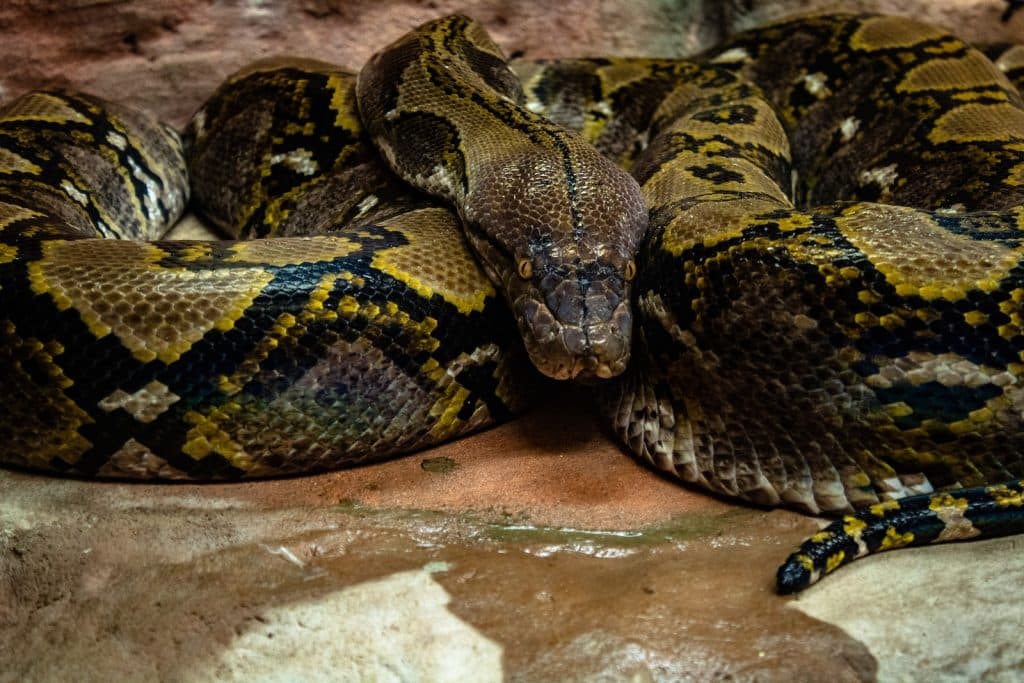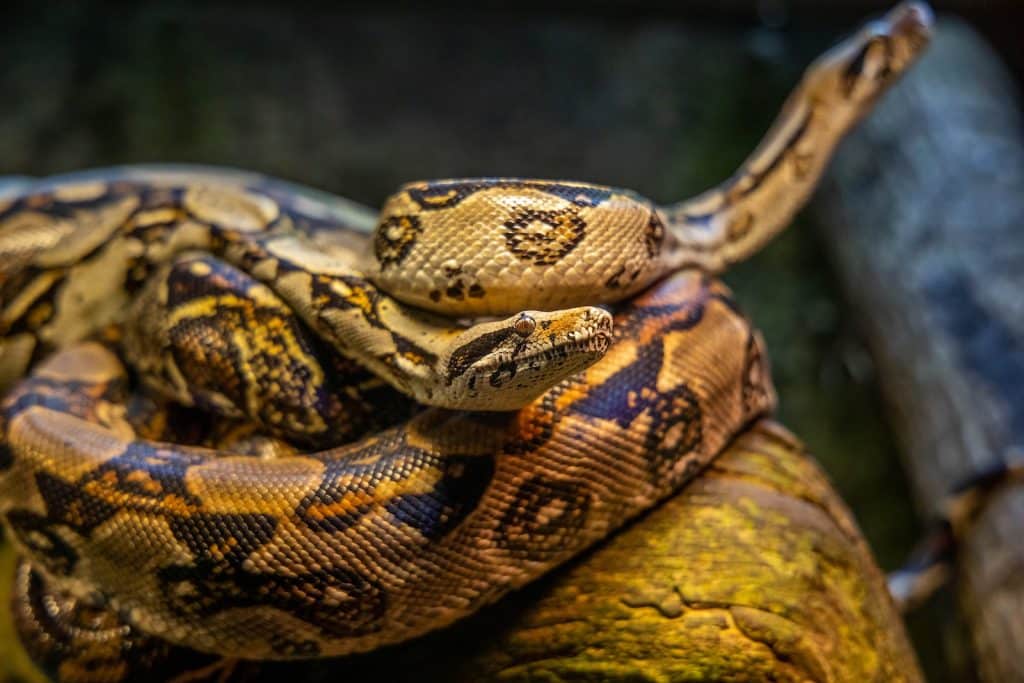
Ophidiophobia is the term that describes the fear of snakes. Humans have always been fascinated by snakes and scared of them.
The most amazing thing about snakes is their ability to grow so large. Is there truth to the Anaconda movie, or is it just fiction? Is there any snake that can eat a human being alive?
It’s not common for snakes to do this, but it is possible. A 54-year-old woman from Indonesia failed to return home after she went to check on her crops. Her sister was worried and went to search for her the next morning. She found her missing sister’s flashlight flip-flops and a machete. The discovery led to a large-scale search that involved more than 100 villages.
They were able to find a massive 23-foot-long reticulated Python, so full that it couldn’t move. They were not surprised to find reticulated pythons in the area. The shape of the last meal was what caught their attention, as it looked very much like a human. They quickly killed the animal and then opened it up to reveal the missing woman.
Despite this terrifying truth, most snakes are not able to take on large prey like humans or deer.
We will take into account both length and weight when determining the size of a snake. These metrics will not allow long-venomous snakes like the king cobra to be included in this list. They are too small and light to carry anything heavier than rodents or other snakes.
Large constrictors like anacondas, pythons, and boas are the best when it comes to size. Constrictors don’t have venom. They kill their prey by wrapping themselves around it and sucking it until it dies. This family is responsible for all the snakes in this list. Let’s get to work, without further delay.
1. Green Anaconda

Common name: Green Anaconda
Scientific name: Eunectes Murinus
Boidae: Family
Length: About 20-29 feet
Weight: Maximum 550 lbs
The green anaconda, which can reach up to 29 feet in length and weigh as much as 550 lbs, is undisputedly the king of snakes. The enormous creature is so heavy and large that it can adapt to aquatic life. It prefers to live in swamps and marshes than drag its heavy body on the ground. Green anacondas, which are large and heavy, have developed their eyes and nostrils to be above their heads so that they can see underwater and breathe.
The green anaconda, a native of South America’s jungles, is the apex predator. No animal is safe in the Amazon rainforest, even jaguars, thanks to heat detection and sight. It is a common prey of caimans (a crocodilian-like species), capybaras, and wild pigs as well as birds and tapirs. These snakes are known for their cannibalistic tendencies. Large females will eat smaller males. The world of green anacondas is dominated by females.
Green anacondas, like other boas, kill their prey by constriction. This involves wrapping their bodies around the prey and pressing down to their death. The dead animal is then eaten headfirst. Like other constrictors, their jaws can be detached, which allows them to swallow large prey. Green anacondas can live for up to a month without eating after consuming large meals.
Green anacondas are solitary and only seek out their mate. They give birth to little babies, which can number up to 80, unlike other snakes. The green anaconda, however, is not endangered.
2. The Reticulated Python

Common name: Python with a tangled tail
Scientific name: Malayopython Reticulatus
Family: Pythonidae
Length: Maximum 33 feet
Weight: Maximum of 320 pounds
The reticulated Python, a constrictor native to Southeast Asia, is a large and beautiful animal. Its striking, network-like skin pattern is called “reticulated,” which is why the animal’s name. Their misery is due to their beautiful skin, which fetches quite a bit in the commercial skin trade. They are still an endangered species, however.
The longest snakes in the world, reticulated Pythons can reach lengths up to 33 feet. Although the average reticulated python is longer than the average green, anacondas are larger, stronger, and more powerful than reticulates. Reticulates isn’t the largest snakes.
To find prey, the pythons of Reticulated use their senses of smell and infrared. They squeeze their prey until it is asphyxiated and then swallows it whole. They eat rodents and deer as well as birds.
They have not preferred pet snakes because of their aggressive nature.
3. The Burmese Python

Common Name: Burmese Python
Scientific Name: Python bivittatus
Family: Pythonidae
Length: Maximum 23 feet
Weight: Maximum 300 lbs
Burmese Pythons are one of the most misunderstood species in America. They are known for their ability to adapt and thrive in the Everglades, driving certain species to near extinction.
They are an evolutionary success story. Burmese Pythons, with their stunning patterns and docile temperament, make them a great choice for anyone looking to keep a large snake in their home. Inexperienced owners may find it difficult or dangerous to take care of them once they reach 23 feet in length. They are often released into the wild as a result.
Burmese pythons can conquer all terrains. They live an arboreal life when they are young and mainly hang out in trees. As they age, their weight and size increase, and they are forced to live on the ground.
They can hold their breath for up 30 minutes and are great swimmers. Even water-dwelling animals are vulnerable to this constrictor. Burmese pythons fight and eat alligators in the Everglades.
Burmese pythons live in solitude and only meet during spring to find mates. The eggs take three months to incubate and can be laid by up to 100 females. Burmese Pythons are now considered to be endangered due to their rampant hunting.
4. African Rock Python
Common name: African Rock Python
Scientific name: Python sebae
Family: Pythonidae
Maximum length: 24 feet
Weight: Maximum 200 pounds
Although some African rock pythons may grow larger than Burmese, Burmese Pythons are generally larger. We ranked them higher because of this.
However, African rock Pythons are Africa’s biggest snakes. They live in Sub-Saharan Africa and use rocky outcrops as hideouts. They also live near water bodies and can be found drinking from thirsty animals. Rock pythons, skilled climbers, are also dangerous for arboreal animals.
African rock pythons, like other snakes, are solitary and only seek out their species for mating purposes. Rock pythons, unlike other reptiles, are nocturnal snakes. The juveniles are active at dawn and dusk, however.
They prey on rodents and small animals when they are younger. However, once they reach adult size, nearly all other animals on the continent are fair game, with the exception of large herbivores or carnivores.
Because of their aggressive nature, African rock pythons are not suitable pets. They are being hunted more often for their skin and meat.
5. Indian Python
Common name: Indian Python
Scientific name: Python Molurus
Family: Pythonidae
Length: Maximum 21 feet
Weight: Maximum 200 Pounds
Although it is called the “Indian” Python, the constrictor’s range stretches as far as China’s Sichuan Province and as far as Borneo. The Indian python can thrive in many habitats including forests, shrublands, woodlands, and rocky foothills. It seems to prefer moist terrains.
The Burmese python belongs to the Indian python subspecies. This is why they have such striking similarities. Their hides sport a rectangular mosaic pattern. Burmese pythons are darker and larger.
Indian python males are smaller than females, much like green anacondas. They are solitary and only mate when they meet. One female Indian python can lay as many as 100 eggs per go. Each egg weighs about 7.3 ounces.
Indian pythons, unlike their cousins, are extremely timid and prefer to flee from danger. These serpents also have a unique trait: they walk in straight lines, which is often called “walking on the ribs”.
Indian pythons eat mostly amphibians, birds, and small mammals.
6. Amethystine (Scrub Python)

Common name: Scrub Python
Scientific name: Somalia amethystine
Family: Pythonidae
Length: Maximum 20 feet
Weight: Maximum 200 pounds
The name amethystine Python derives its name from its amethyst-like scales. It is also known as the “scrub python” in northern Australia because it lives mostly in the scrublands.
The amethystine Python, like its cousins, is remarkably adaptable. Its range extends across most of Oceania.
Scrub pythons, which are also solitary animals, prefer to hunt at night. They live in an arboreal life as juveniles and only become ground dwellers once they are adults. Like most pythons, they are excellent swimmers. This allows them to add water-dwelling animals to their diet.
To capture prey, Amethystine Pythons employ the “sit-and-wait” strategy. It involves staying still in a spot that allows their scales to blend into the surrounding environment and striking with incredible speed at any prey they encounter.
Female amethystine Pythons can lay up to 20 eggs per season. Although this may seem small compared to other species of pythons that can lay as many as 100 eggs at once, the numbers of scrub pythons remain steady.
7. Yellow Anaconda
Common name: Yellow anaconda
Scientific name: Eunectes Notaeus
Boidae: Family
Maximum length: 15 feet
Weight: Maximum 121 lbs
The yellow anaconda, a South American native, is a large snake. It can grow up to 15 feet in length and weigh up to 121 lbs. The snake’s name is derived from the dominant color, yellow.
As with the green anacondas and other species, females have a larger sex than males. This species prefers to live in water. But, yellow anacondas are more likely to venture onto the land than green anacondas to hunt for terrestrial prey. However, their prey is mostly aquatic or semi-aquatic animals such as birds, fish, amphibians, and small mammals.
A yellow anaconda female releases a pheromone when she reaches sexual maturity. This attracts males. Many males will appear, resulting in a scene that is nothing short of a nightmare: several snakes wrapped up into a ball and twisting their way to the nest. Courtship is most often in water. The female gives birth after six months to up to 82 children, who start to take care of themselves.
Yellow anacondas, despite their size, are very timid and prefer to flee than fight. Although they are a popular target for poachers their numbers are stable.
Conclusion
Snakes are one of the most fascinating creatures on Earth. Our fascination with the giants of the snake realm is almost unbelievable. The Titanoboa, which was the largest known snake, is a titan. The Titanoboa, which measured up to 42 feet in length and weighed well over 2,500 lbs, was truly a goliath.
This is a significant difference from the Titanoboa, which was near twice the length and almost five times the weight of the largest known green anaconda. It’s clear that if the Titanoboa had not died out 56 million years ago we would have been just another item on their menu.
Which is larger, the anaconda or the python?
Anaconda vs. Python: Size An anaconda is shorter than a python, reaching up to 22 feet long and weighing up to 550 pounds. The anaconda is a gigantic reptile with a circumference of up to 12 inches. Although the python is longer, the anaconda is thicker and heavier, thus it wins.
Is the Cobra larger than the Anaconda?
Anaconda vs. King Cobra: Size Anacondas are far bigger than king cobras. The normal anaconda may grow to be 22ft long, but the longest ever discovered was 33ft long and weighed over 800 lbs. The king cobra may grow to be fairly big, reaching a maximum length of 19ft. The snake, on the other hand, weighs just 15 pounds.
What is the name of the snake king?
Their most notable prey, however, is other snakes! California Kingsnakes are called “kings” because they seek and consume other snakes, including other kingsnakes and rattlesnakes – they are immune to rattlesnake poison!
What animal is stronger than a cobra?
The capacity of the mongoose to battle and kill dangerous snakes, particularly cobras, is well recognized. Their specialized cholinergic receptors protect them against venom. In this video, a struggle between a mongoose and a snake halts traffic
What snake can compete with a king cobra?
The rocks python There is no doubt that king cobras take huge prey such as monitor lizards or even pythons on occasion. One couldn’t help but marvel at how the snake is able to make quick judgments and weigh the dangers and benefits of chasing prey like a rock python, which can kill the cobra by constriction.
Is there a snake that is 100 feet long?
An incredibly long serpent has been discovered, raising the question: What are your favorite examples of image manipulation? The Daily Telegraph says today that a 100ft (30m) snake has been sighted hiding in a river in Borneo, provoking significant alarm among local populations”.
How large can an anaconda grow?
30 feet Green anacondas are among the world’s biggest snakes. Females are much bigger than males. They may grow to be 30 feet (9 meters) long, 12 inches (30.5 cm) wide, and weigh 550 pounds (250 kilograms)
What is the largest python ever discovered?
around 26.25 feet long The Reticulated Python is a favorite snake among skilled reptile keepers. The longest python ever lived was around 26.25 feet (8 meters) long and weighed approximately 550 pounds (250kg). In 2016, a big reticulated python was captured in Malaysia.
What was the size of the largest prehistoric snake?
42.7 feet The snake, named Titanoboa cerrejonensis by its discoverers, weighed 1,140 kilograms (2,500 pounds) and measured 13 meters (42.7 feet) from nose to tail tip.
Which of the following is the world’s two largest snakes?
The world’s largest species Rank Range map with common names 1 anaconda green two Burmese pythons 4 Central African rock python 3 reticulated python Python Range is depicted as a green zone. ten additional rows